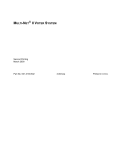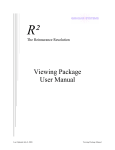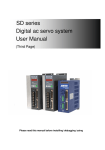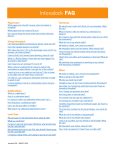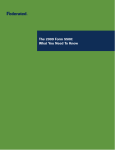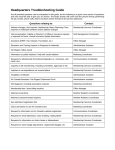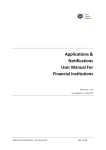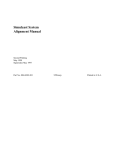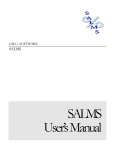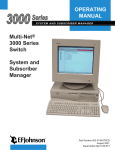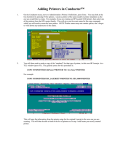Download User Manual for By SALT Solutions, Inc.
Transcript
User Manual for
By
SALT Solutions, Inc.
Copyright 2009
http://actuarialauditor.saltsolutions.com
Table of Contents
Overview ........................................................... 4
SAVE Life Windows Software ....................... 5
Calculating a XXX reserve ............................. 5
Contact Us ........................................................ 5
CRVM and Unitary Reserves ......................... 5
Deficiency Reserves ......................................... 7
Toolbar Documentation .................................. 8
Global Variables .............................................. 9
Two Life Policies .............................................. 9
Values that vary by duration ........................ 10
Methods and Dates ........................................ 13
General ........................................................... 14
Policy Input .................................................... 14
Benefits and Premiums.................................. 16
Interest Rate Input ........................................ 18
Factors Input - Only available for XXX
Calculations .................................................... 18
Mortality rates and Select Factors ............... 19
Mortality Calculations................................... 20
Segment........................................................... 21
Cash Values .................................................... 21
Confidential
Page 2 of 31
Last updated on 3/31/2009
http://actuarialauditor.saltsolutions.com
Minimum Assumptions and Miscellaneous
XXX................................................................. 22
Comparison of values using XXX
methodology ................................................... 23
Mid Year ......................................................... 24
Return of Premiums ...................................... 25
Smoothness ..................................................... 26
Report Type.................................................... 27
Report Documentation (Commutation
Reports) .......................................................... 28
Report Documentation (Detail Reports) ...... 29
Report Documentation (Summary Reports) 30
Confidential
Page 3 of 31
Last updated on 3/31/2009
http://actuarialauditor.saltsolutions.com
Overview
Have you ever calculated reserves and cash values with large software packages only to
find out too late that you calculated them incorrectly because you didn't input all of your
data correctly? If it hasn't happened to you yet, you are probably younger than I. It has
happened to me.
What is needed to solve this problem is an easy-to-use online tool that doesn't have all of
the "bells and whistles" but just performs the basic calculations. This is the goal for
Actuarial Auditor.
There are three editions of the Actuarial Auditor: Premium, Standard, and Free. This
manual will focus on the Premium edition but will also document differences in all three
versions. Our web site has a document that shows the differences between these three
editions.
I have personally found this tool helpful in performing audits for insurance departments
as well as validating calculations that I perform for our clients. I hope that you find it
useful as well.
David L. Kester, FSA, MAAA
President of SALT Solutions, Inc.
For more information about SALT Solutions, go to our website www.saltsolutions.com.
Confidential
Page 4 of 31
Last updated on 3/31/2009
http://actuarialauditor.saltsolutions.com
SAVE Life Windows Software
The Actuarial Auditor replaces the Windows based SAVE Life. SAVE Life will no
longer be supported. Generally, all of the functionality that existed in SAVE Life exists
in the Actuarial Auditor. The traditional life and universal life components of SAVE Life
have been split into separate online tools in Actuarial Auditor. This allows the user to
only purchase the tool that they need as well as simplifying each module. This manual
documents the traditional life component.
.
Calculating a XXX reserve
On the input page, choose a reserve value calculation type. Choose one of the XXX
reserve methods (see Methods and Dates). All of the XXX input will now be enabled
(See Segment, Cash Values, Minimum Assumptions and XXX Miscellaneous).
Several XXX specific reports will be available for the user to choose as well. These will
be found in the Report List Box at the bottom of the input page.
See Mortality Calculations and Report Documentation (Summary Reports)
Although many of the features and formulas for XXX are incorporated into the Actuarial
Auditor program, the user must be familiar enough with the regulation to make correct
input decisions that are not automated. For example, all of the mortality tables are
available if the user chooses a XXX method. However, only the 1980 and 2001 CSO
tables are appropriate.
Calculating Return of Premium Cash Values
There is a special document created that the provides details on how to calculate return of
premium cash values.
Contact Us
You may contact us for technical support or inquires. Contact Us (Click on the link). No
support provided for the Free edition.
CRVM and Unitary Reserves
Regulation XXX redefines the Commissioners' Reserve Valuation Method (CRVM) as
the reserve resulting from using the XXX methodology (Section 1B). Further, it defines
Confidential
Page 5 of 31
Last updated on 3/31/2009
http://actuarialauditor.saltsolutions.com
Unitary Reserves (Section 4K1) as the reserves resulting from a traditional modified net
premium calculation. Actuarial Auditor has adopted this terminology and will avoid
using the term CRVM wherever possible to avoid confusion.
Confidential
Page 6 of 31
Last updated on 3/31/2009
http://actuarialauditor.saltsolutions.com
Deficiency Reserves
Deficiency reserves are calculated using the Minimum mortality assumptions. The user
must choose a XXX method. The deficiency reserves are a separate output item in the
XXX Summary Report. Unlike previous definitions, the XXX regulation defines
deficiency reserves in terms of the difference between two reserves (Minimum and Basic)
rather in terms of the difference between two premiums. See section 4C of the XXX
regulation.
For more information on the output from Actuarial Auditor for deficiency reserves, see
Report Documentation (Summary Reports) and Report Documentation (Detail Reports).
Confidential
Page 7 of 31
Last updated on 3/31/2009
http://actuarialauditor.saltsolutions.com
Toolbar Documentation
Case ID
This will allow the user to quickly navigate to a saved case. It also provides the user a
convenient method for viewing the saved cases.
Run
This button processes all of the input items, and displays an output file that contains
either Reserve or Cash Value information. The system will validate the input before
processing. The output format will depend upon which output format the user chose on
the input page.
Save
This button will save the information currently displayed on the form for that case.
New
This button will create a new saved case. The default values for the new case will be the
values that are showing on the input form when the Add button is clicked.
Delete
This button will delete the entire input data from the database for the current case.
Cancel
This button will cancel the changed data on the form for that case and reset the data on
the form to the previously stored data. It will cancel ALL changes to the current case
since it was last modified.
Formulae
Loads a PDF file that documents the formulae that are utilized in Actuarial Auditor
Rounding Definitions
Opens a form for the user to define the rounding that will be used for all cases for a given
user.
Help
Loads this PDF file that provides assistance on how to properly operate Actuarial Auditor
Confidential
Page 8 of 31
Last updated on 3/31/2009
http://actuarialauditor.saltsolutions.com
Global Variables
The global variable input items remain constant for all cases. Variables that have been
added to this section tend to remain constant for all cases and thus minimizing user input.
The rounding input has two steps. The first step is to define the rounding on a per unit
basis. The second step is to define the rounding when the number of units is multiplied
by the per unit values. The first step should produce values that match per unit values
often printed in manuals or tables. The second step should match a specific policy once
the number of units have been applied.
Note that the summary reports show the values AFTER the number of units have been
applied and the rounding of those values. The detail reports show the per unit values
BEFORE the per unit rounding. This allows the user to see the values the system
generates before any rounding or unit multiplication occurs.
Two Life Policies
SAVE Life calculates reserves and cash values for policies insuring two lives on a last
survivor basis. The user can input a mortality table and select table for each life.
Actuarial Auditor will "frasierize" the two mortality rates into one on an exact issue age
basis. This process was introduced by W. M. Frasier in the article “Second to Die Joint
Life Cash Values and Reserves” in The Actuary, XII, (1978). In more modern literature,
this process is documented in the "Products and Finance" textbook by David B.
Atkinson, FSA and James W. Dallas, FSA.
Confidential
Page 9 of 31
Last updated on 3/31/2009
http://actuarialauditor.saltsolutions.com
Values that vary by duration
The Actuarial Auditor application allows the user to input varying data with the help of a
grid. If the user selects “Vary by Duration” from the drop down list a button
appear.
will
When this
button is clicked a new form (as shown below) with the information regarding
the all input variables that may vary by duration will appear.
Confidential
Page 10 of 31
Last updated on 3/31/2009
http://actuarialauditor.saltsolutions.com
Click the export to spreadsheet button to export the values in the grid to a csv spreadsheet.
The values cannot be modified within this window, but can be within the spreadsheet (shown
below.)
Confidential
Page 11 of 31
Last updated on 3/31/2009
http://actuarialauditor.saltsolutions.com
The first column “ValueID” is a the case number, and it should be constant for each
individual case. DO NOT CHANGE THIS NUMBER. The second column “Dur” is the
duration. It should start at one and be incremented by 1 until the last duration. Every other
column is an input variable that may vary by duration, depending on the options selected on
the input page.
When the user is done updating the vary by duration data, copy all the values from the
spreadsheet (make sure to DO NOT include the column headings), return to the vary by
duration window and paste the data in the large blank field below the table. After pasting the
data, click the save values button, and close the window.
Confidential
Page 12 of 31
Last updated on 3/31/2009
http://actuarialauditor.saltsolutions.com
Methods and Dates
The unitary method is the traditional CRVM (see CRVM and Unitary Reserves)
calculation with a possible first year expense allowance. If benefits or premiums vary by
duration, Actuarial Auditor can use the Menge or Traditional Interpretation in how to
determine the death benefit in the expense allowance calculation. This method is
explained in detail in the Bowers, Gerber, Hickman, Jones, and Nesbitt "Actuarial
Mathematics" Textbook.
The Tabular COI method calculates the reserve on a tabular cost of insurance basis. This
will result in zero terminal reserves and a mean reserve equal to the interpolated net
premium.
Actuarial Auditor supports 3 XXX Methods. XXX 1999 method is the 1999 version of
the XXX regulation. XXX YRT/ART (Section 6E or 6F) and XXX Unitary Exemption
(Section 6G or 6H) are optional XXX calculation options. All of the other methods are
independent of XXX regulation. See Calculating a XXX reserve.
Actuarial Auditor currently supports the 1941 Minimum Cash Value method if the
premiums and death benefits are level for all durations.
All reserve and cash value methods allow the user to choose whether they compare the
mid year reserve (mean or mid terminal) to a ½ Cx calculation. This option is available in
the Mid Year Section of the input page.
The issue and valuation dates are used to determine the current reserves. Although
reserves are calculated and displayed for all durations, the summary reports will show the
terminal and mean reserves for the current duration. If the user chooses to define the mid
year interpolation other than "Half Year", these dates will also be used to define the
interpolation for the mean reserve calculation.
Confidential
Page 13 of 31
Last updated on 3/31/2009
http://actuarialauditor.saltsolutions.com
General
Report for Client: An input item is to provided for the user to document which client /
company this case is associated. It is only used for documentation. It will be displayed in
many of the reports.
Client Notes: An unlimited capacity for the user to document necessary details regarding
this case.
Issue Date: Enter the issue date for the policy. Only used to determine the final reserve
to print in the heading of the summary report.
Valuation Date: Enter the valuation date. Must be after the issue date. Only used to
determine the final reserve to print in the heading of the summary report. See Methods
and Dates for more details.
Policy Input
Case Documentation {Premium edition} / Policy Number {Standard edition}: This is
a text field that allows the user to enter the case documentation or policy number. It is
only used for documentation purposes. It will be included in the output reports. It is also
what is used to populate the list box that shows all of the case ID’s at the top of the form.
Number of lives: If two lives are chosen, the user will need to input the issue ages and
mortality rates for both insureds. The user will also have the option to input select factors
for both insureds if needed. Actuarial Auditor will frasierize the two mortality tables into
one table on an exact age basis. See also Mortality rates and Select Factors, Mortality
Calculations. The formulae documentation details this calculation.
Values: Choose whether to calculate reserves or cash values.
Method: Choose the reserve or cash value method. See Methods and Dates for more
details.
Issue Age: If two lives are chosen, input the exact issue age for both insureds. Actuarial
Auditor will frasierize the mortality based upon the issue ages input. You must input the
younger insured as the first insured.
Ending Issue Age: The last issue age to calculate. Only available in the premium
edition.
Step: The definition for how to define the issue ages to calculate between the beginning
and ending issue ages. For example, if you want to calculate values for issue ages 25, 35,
and 45, enter a value of 10 for the steop. Only available in the premium edition.
Confidential
Page 14 of 31
Last updated on 3/31/2009
http://actuarialauditor.saltsolutions.com
Gender: This is only enabled if the user chooses a XXX method. It will be used to
determine the correct select factors after the first segment.
Number of Years of Unitary and Grading to Net Level: To reproduce the New Jersey
Method, enter 1 year of Unitary CRVM and then 19 years of grading to the Net Level
reserve. This would produce a Net Level reserve after 20 years.
Confidential
Page 15 of 31
Last updated on 3/31/2009
http://actuarialauditor.saltsolutions.com
Benefits and Premiums
Benefit and premium timing: The timing for the expense allowance is a separate input
item. A continuous benefit assumption uses the uniform distribution of death (UDD)
approximation. This results in the traditional δ factor to apply to the curtate death benefit
values. A continuous premium assumption also assumes a uniform distribution of deaths
(UDD). This assumption can be summarized by an α and β parameters as defined in the
Life Annuity chapter of the Bowers, Gerber, Hickman, Jones, and Nesbitt "Actuarial
Mathematics" Textbook. This is similar to but not exactly equal to a traditional
approximation of assuming a linear function Dx. The UDD premium assumption can be
shown to provide more consistent approximations than the linear Dx function.
A continuous discounted mean option is provided. The discounted continuous mean
premium represents the approximation of the premium to be refunded in the event of
death. For that reason it is more appropriate to use in a Mid Year Reserve formula. The
displayed net premium in the summary output reports will be the unadjusted net
premium. However, if this option is chosen, it will affect the mean reserve in the output.
See the TRANSACTIONS OF SOCIETY OF ACTUARIES 1995 VOL. 47 “Equivalence
of Reserve Methodologies” pages 455-478 By Keith P. Sharp and references mentioned
within this publication for more detail discussion on discounted continuous premiums.
Curtate Expense Allowance: If selected, the expense allowance will assumed to be
curtate. If not selected, the expense allowance will be consistent with the timing
assumption. Thus, if the timing assumption is semi continuous and the curtate expense
allowance is not checked, then the expense allowance will be semi continuous.
Benefit cease age: Enter the age that the benefit and the policy will cease. The user may
enter 999 for the system to assume that the benefit will cease at the end of the mortality
table.
Premium cease age: Enter the age that the premium will cease. The user may enter 999
for the system to assume that the premium will be paid for the entire policy.
Policy Fee: Will only be used to determine deficiency reserves. The user has an option
whether to include the policy fee in the segmentation calculation. See Segment. Actuarial
Auditor does not support policy fees that vary by duration as a separate input item.
Number of Units: All values are calculated in two stages. The first is on a per unit basis.
After the per unit calculations are performed, the values are rounded. The second stage is
to multiply the rounded per unit value by the number of units and rounded again. This
methodology allows users to replicate the majority of methods systems utilize to derive
the final values. The summary reports display values after the number of units have been
applied and all rounding performed. The detail reports display values after the per unit
values have been calculated but before any rounding. This allows the user to identify the
calculated values before any rounding has been applied.
Confidential
Page 16 of 31
Last updated on 3/31/2009
http://actuarialauditor.saltsolutions.com
Full Preliminary Term Criteria: User can choose between the Menge or Traditional
Interpretation in how to determine the death benefit in the expense allowance calculation
19 Pay Death Benefit: This option is not needed if the benefits are constant, the method
is net level, or if a minimum cash value method is chosen. ELRA (Equivalent Level
Renewal Amount) follows Menge’s interpretation for how to define the expense
allowance death benefit. Actuarial students will be familiar with this method as it is
described in the Bowers, Gerber, Hickman, Jones, and Nesbitt "Actuarial Mathematics"
Textbook Average death benefit will calculate the arithmetic average of the death
benefits in years 2-10. This methodology has been the more consistent methodology
since the introduction of the 1980 CSO tables.
Death Benefit: If the death benefit varies by duration, the user will need to enter the
death benefits by clicking the
button. The user may also modify all of the variables
that vary by duration by clicking this button. See values that vary by duration.
Constant Death Benefit: If the user chooses the death benefit pattern to be constant, then
the user will need to enter the constant death benefit in this input box.
Gross Premium: If the gross premium varies by duration, the user will need to enter the
death benefits by clicking the
button. The user may also modify all of the variables
that vary by duration by clicking this button. See values that vary by duration.
Constant Gross Premium: Choosing a constant gross premium will result in a constant
net premium. The gross premium will be used to determine segmentation and deficiency
reserves for a XXX calculation. Enter the gross premium without policy fee.
Endowment: The likely option will be the One Payment choice. This will pay an
endowment at the time that the benefit ceases. For example, an endowment at 65 policy
would choose this option and the system would pay an endowment at age 65. Choosing
an endowment that varies by duration, it can be used to calculate values for retirement
income policies. If the endowment varies by duration, the user will need to enter the
death benefits by clicking the
button. The user may also modify all of the variables
that vary by duration by clicking this button. See values that vary by duration.
Single Endowment: Only used if the One Payment endowment type is chosen and if the
mortality rate is less than one at the benefit cease age.
Confidential
Page 17 of 31
Last updated on 3/31/2009
http://actuarialauditor.saltsolutions.com
Interest Rate Input
Interest rate type: The user has the option to choose the interest rates that vary by
duration. See values that vary by duration. It is assumed that if either the basic or
minimum interest rate varies by duration, then both of them will vary by duration.
Interest Rate: Enter the interest rate as a decimal (e.g. 0.045). The basic interest rate is
used in all of the calculations. For a XXX calculation, it is used to calculate the Basic
values. The minimum interest rate is only used for XXX calculation to determine
deficiency (minimum) reserves.
Factors Input - Only available for XXX Calculations
X Factor type: The user has the option to choose the X Factor to be constant for all
durations or vary by duration. See values that vary by duration. Generally, the X Factor
will be between 0.20 and 1.00. The X factor will only be used in the first segment.
10 Year Factor after 1st Segment: If none is chosen, then there will not be a select
factor after the first segment in a XXX calculation. The user is presented with other
options to include the 10 year factor after the 1st segment. The system uses the gender
that the user entered to determine which 10 year selection factor to use. The system will
use either the male or the female 10 year factors or a combination of the two.
Confidential
Page 18 of 31
Last updated on 3/31/2009
http://actuarialauditor.saltsolutions.com
Mortality rates and Select Factors
Regulation XXX has guidelines on which mortality rates and select factors are allowed.
The user is responsible for choosing the mortality rates and factors that are consistent
with the regulation. The select factors chosen are only used in the first segment. If the
user chooses "10 Year Factor After 1st Segment", then the system will chose the select
factors in the renewal segments based upon the gender that was entered. This option
should only be used if the user chooses a 1980 CSO mortality table.
Basic Mortality Tables and Select Factors: These rates will be used for all of the
calculation methods. If the user chooses a 2001 CSO select and ultimate table, the system
will convert to the ultimate part of this table after the first segment. If the user chooses a
2001 CSO table and a XXX method, then the user should not choose a select table. For a
XXX method, if the user chooses the one year term comparison, then it will use the
Tabular COI mortality and Select factors. For a non XXX method and the user chooses
the one year term comparison, then the system will use the Basic Mortality and Select
factors.
Tabular COI Mortality Tables and Select Factors: These rates will only be used for a
one year term comparison for a XXX method. If the user chooses a 2001 CSO table, then
the user should not choose a select table. For a XXX method, if the user chooses the one
year term comparison, then it will use the Tabular COI mortality and Select factors. The
only select factors that will be displayed will be the ones that are allowed for XXX for
the purposes of comparing to a one year term calculation.
Minimum Mortality Tables and Select Factors: These rates will be used to calculate
minimum and deficiency reserves for XXX. If the user chooses a 2001 CSO select and
ultimate table, the system will convert to the ultimate part of this table after the first
segment. If the user chooses a 2001 CSO table, then the user should not choose a select
table.
Confidential
Page 19 of 31
Last updated on 3/31/2009
http://actuarialauditor.saltsolutions.com
Mortality Calculations
The individual mortality rates are calculated considering these factors: the base mortality
rate, the select factor, and the X factor (Minimum assumptions only). Which value to use
for each of these variables depends on several variables: which segment (1st or renewal),
and the user input of the various mortality tables and select factors.
Generally, the select factors are not used in the renewal segments. There are two
exceptions. 1. If the user selects the "10 year factor after the first segment" option. 2. For
the tabular cost of insurance calculation, the select factors will be used up to 10 years.
For a 2001 CSO XXX calculation, the base mortality uses the ultimate scale after the first
segment. No separate select factors should be used for a 2001 CSO XXX calculations.
The select mortality can be utilized by choosing a 2001 select and ultimate mortality
table.
If the policy insures two lives, then the individual mortality rates are frasierized to
produce a final mortality rate. For two lives, this rate is on a last to die basis.
Actuarial Auditor provides some (but not all!) limitations regarding which mortality
options are available for a XXX calculation. However, the user must make the final
decisions. See the formulae documentation for more details.
See Calculating a XXX reserve.
Confidential
Page 20 of 31
Last updated on 3/31/2009
http://actuarialauditor.saltsolutions.com
Segment
Segment Ratio Definition: Allows the user to be able to select how the segmentation is
defined for "close" mortality ratios based upon the "contract segmentation method"
defined in section 4B of XXX. The regulation defines that R t may be increased or
decreased by 1% but does not state whether this is additive or multiplicative. The system
allows the user to choose either option.
Use Policy Fee in Segmentation: Regulation XXX (Section 4B) does not require policy
fees to be included in the segment calculation if they are level.
Segment Endowment Option: Section 6A of the XXX regulation allows the insurer to
choose these endowment options.
Segment Endowment Rule: Determines which set of calculations to apply the segment
endowment option.
Cash Values
Cash Value Input: Regulation XXX (Section 6D) requires an additional floor
comparison to make sure that any unusual pattern of cash values are reserved or the user
may want to compare to the cash values. If the user wants to ignore these comparisons,
chose "Zero". To make the comparisons, choose "Vary by duration". The user may
manually enter the cash values by clicking the
button.
Compare to Basic Mid Year: If the user wants to compare the cash values to the basic
mid year reserve, check this option. The system will convert the terminal cash values that
the user entered into mid year cash values for the purpose of this comparison.
Unusual Cash Values Test: Choose this option to enforce the Section 6D of the XXX
regulation.
1st Year Surrender Charge: This is used in the unusual cash value test. Enter the total
amount of the first year surrender charge.
Nonforfeiture interest rate: This is used in the unusual cash value test. Enter as a
decimal value.
Confidential
Page 21 of 31
Last updated on 3/31/2009
http://actuarialauditor.saltsolutions.com
Minimum Assumptions and Miscellaneous XXX
Mean Reserve Definition: This option is used only if the user chooses the mid year
definition to be the mean reserve (see Mid Year). For the mean reserve calculation, this
allows the system to use the gross premium if it is less than the net premium. Choosing
the "Calculated Net Premium" option will always use the net premium in the mean
reserve.
Net Premium Definition: This option affects how the net premium is defined in the
output. This option is used for all XXX calculations. The "Mean Reserve Definition"
defined how the net premium is used in the mean reserve calculation. It is recommended
that these two input items to be consistent.
Policy Fee Per Unit: Since the net premium is a function of the gross premium, the
policy fee potentially affects the net premium. Also, for minimum reserves, the policy fee
may impact the deficiency reserves.
Unitary, Segment Choice: This option is used when the system is comparing the unitary
and segmented reserves to determine the largest value for the net premium, terminal, and
mean reserves. For example, if the mid year basic segmented reserve is larger than the
mid year basic unitary reserve, then the basic segmented net premium is defined as the
net premium to output.
Confidential
Page 22 of 31
Last updated on 3/31/2009
http://actuarialauditor.saltsolutions.com
Comparison of values using XXX methodology
After all of the reserves and net premiums have been calculated for different mortality
assumptions, XXX requires a comparison of these values to determine which is to be
considered the final value. Actuarial Auditor calculates a final Basic value and a final
Minimum value.
How the system determines the final value for a given reserve or net premium depends
upon many factors. One factor is the reserve method chosen. If the reserve method
chosen is XXX Unitary Exemption, then the unitary values will be disregarded.
A second key factor is whether there is a comparison to the one year term comparison
(see output tab). If that option is selected, then the one year term reserve will affect the
mid year comparison.
A third key factor is which option the user chose for the “unitary, segment choice” input.
If the user chooses “compare terminals”, then the terminal values will be compared. If
the user chooses “compare mid year”, then the mid year values will be compared.
For example, if the user chooses “compare terminals” then the final minimum net
premium will be the unitary net premium if the Basic unitary terminal is greater than the
Basic segmented terminal. Likewise, the final net premium will be the segmented net
premium if the Basic segmented terminal is greater than or equal to the Basic unitary
terminal. Note that based upon section 6B1 of the XXX regulation, this comparison is
made at each duration. See the Formulae documentation for details regarding the
comparison procedures.
Confidential
Page 23 of 31
Last updated on 3/31/2009
http://actuarialauditor.saltsolutions.com
Mid Year
Reserve Definition: Choosing the mean will result in all of the mid year reserve values
to include the net premium.
One Year Term Comparison: Choosing this option will result in the mid year reserve to
be compared to the net premium for a one year term insurance ("one half Cx"). This net
premium will equal ½ Cx if the interpolation is half year. Other interpolated values will
result in different values used in this comparison. For a XXX calculation, this comparison
will use the mortality defined by the "Tabular COI" input. All other calculations will use
the mortality defined by the "Basic" input.
Interpolation: This determines how to calculate the mid year reserve values as well as
the "one half Cx" comparison if that option is chosen. Exact day considers all days in the
year, including leap days. Next month will interpolate to the next monthaversary day if
the valuation date is not on a monthaversary. This interpolation only considers the
months in a year.
Rounding Order: Choosing to round the terminals and net premium first will result in
those values to be rounded when the mid year reserve is calculated.
Confidential
Page 24 of 31
Last updated on 3/31/2009
http://actuarialauditor.saltsolutions.com
Return of Premiums
Return of Premium: “None” chooses that there is no return of premiums. This is not a
valid option if the method is AG_CCC. ‘ROP – CV Only” provides a return of premiums
in the form of cash values (and possibly endowment) but not included in the death
benefit. “ROP – DB & CV” provides a return of premiums in the form of cash values
and death benefit. For both of these options, the user can also include an endowment
option by the option below “Endow Period (Duration). If the returned premiums are
included in the death benefit (“ROP – DB & CV”), do NOT input these returned
premiums in the death benefit section.
If you have selected a return of premium option, then you will need to enter the
percentages of accumulated premiums by duration that will be returned. You enter these
percentages, as a decimal, by clicking on any of the boxes that have three dots (…) to
open the form that allows you to enter values that vary by duration (See Values that vary
by duration). Enter 1 at the duration of the endowment period if 100% of the premiums
are returned at that duration. The percentages before the endowment duration will be
interpreted as cash values and also death benefits if the “ROP – DB & CV” option is
selected.
Endow Period (Duration): If the user selects one of the Return of Premium options,
then they have an option to choose an Endowment. Enter the duration of the endowment
in this text box. For example, 20 will result in the premiums to be returned as an
endowment in duration 20. Note that there is also an endowment entry option (See
Benefits and Premiums). The final endowment that will be used will be the maximum
endowment from that endowment and the endowment entered in this section. If the
endowment is a return of premium, it is recommended that the user enters that
information in this section and not in the “Benefits and Premiums” section.
Policy Fee included in ROP: If the policy fee is included in the premium that is
returned, select this option. If the policy fee is not included, then do not select this
option.
Test Current Premium: Actuarial Guideline CCC states that if there exist a current
premium scale that is returned that is different than the guaranteed scale, then the
minimum cash values are the ones that produce the greatest cash values testing both
premium scales. To test the current premiums, select this option. You will need to enter
the current premiums on a per unit basis, similar to the method that the guaranteed
premiums were entered by clicking on any of the three dots button “…” to open the
values that vary by duration form (See Values that vary by duration).
Confidential
Page 25 of 31
Last updated on 3/31/2009
http://actuarialauditor.saltsolutions.com
Smoothness
Test for Smoothness: Selecting this option will test to determine if the cash values pass
the smoothness test based upon the language of the 1980 SNFL. Actuarial Guideline did
not add additional language to the test other than it must be performed to satisfy this
guideline. See the discussion forum
(http://actuarialauditor.saltsolutions.com/Forum/Topics.aspx) to see more details
regarding this test.
1st Segment Definition: The segments for the smoothness test generally are 5 years
duration. The user can extend the first segment to be longer by selecting “Variable”. The
system will begin with a first segment of 5 years. If a set of Non Forfeiture Factors
(NFF) can be found that meet the smoothness criteria, then the system will use those
NFF’s. If a set of NFF’s cannot be found, then the first segment will be extended to 6
years. The process will continue until a set of NFF’s can be found that meet the
smoothness test or the maximum first segment duration is reached. See the formula
documentation for more details on this maximum definition.
Confidential
Page 26 of 31
Last updated on 3/31/2009
http://actuarialauditor.saltsolutions.com
Report Type
The user may choose which reports to produce by selecting any of the output report
choices in the Report section of the input page. Actuarial Auditor will save the user's
report selection when they choose to save the data. The reports that are available for a
given case will depend upon the policy type, values calculated, and the methodology
chosen.
Actuarial Auditor supports 2 output formats:
PDF: This is the quickest and simplest format. The reports will be opened as a pdf file in
the user’s browser.
Excel: This format is useful if the user wants to view the data in a spreadsheet. Most
spreadsheets will easily read these files with each column being imported into a separate
column in the spreadsheet. All the reports are shown on one worksheet of an excel
workbook.
See Report Documentation
Confidential
Page 27 of 31
Last updated on 3/31/2009
http://actuarialauditor.saltsolutions.com
Report Documentation (Commutation Reports)
The commutation reports are listed below. The policy type, the values calculated (reserve
or cash value), and the method determine which reports are available.
Basic Commutation Functions 1: Calculates the final mortality after all of the select
factors have been applied using Basic assumptions. It also displays the commutation
functions
M x , M x , Nx , Nx
Basic Commutation Functions 2: Uses the final mortality after all of the select factors
have been applied using Basic assumptions. It displays the commutation functions
lx , Cx , Cx , Dx , Dx
Tabular COI Commutation Functions 1: Similar to the Basic Commutation functions
except the Tabular COI mortality is used.
Tabular COI Commutation Functions 2: Similar to the Basic Commutation functions
except the Tabular COI mortality is used.
Minimum Commutation Functions 1: Similar to the Basic Commutation functions
except the Minimum mortality and interest rates are used.
Minimum Commutation Functions 2: Similar to the Basic Commutation functions
except the Minimum mortality and interest rates are used.
See Report Documentation (Summary Reports) and Report Documentation (Detail
Reports)
Confidential
Page 28 of 31
Last updated on 3/31/2009
http://actuarialauditor.saltsolutions.com
Report Documentation (Detail Reports)
The detail reports are listed below. The policy type, the values calculated (reserve or cash
value), and the method determine which reports are available. All values in the detail
reports are on a per unit basis before any rounding has been applied. This allows the user
to review the calculations before any rounding has been performed or number of units
have been applied.
Basic Unitary Detail: Calculates äx, Present Value of Future Benefits, Present Value of
Future Gross Premiums, Net Annual Premium, Net Level Reserves, Modified Net
Premiums, and Modified Reserves. If the reserve method is net level, then the modified
values will be the same as the net level. In addition, the header provides results for the 19
Pay Premium, Expense Allowance Death Benefit (See Benefits and Premium), Definition
as to the expense allowance type (high premium or low premium), and the r factor using
full preliminary term assumptions.
Basic Segmented Detail: Similar to the Basic Unitary Detail except the present values
are based upon the segmentation results.
Minimum Unitary Detail: Similar to the Basic Unitary Detail except the Minimum
mortality assumption is used. This report does NOT include any deficiency reserves.
Minimum Segmented Detail: Similar to the Basic Segmented Detail except the
Minimum mortality assumption is used. This report does NOT include any deficiency
reserves.
Deficiency Detail: The values are provided for 3 different deficiency calculations. The
ART calculations result from the Tabular COI mortality assumptions and comparing to
an ART mean premium. The minimum unitary and minimum segmented calculations
result from using the minimum mortality assumptions. Traditional reserve methodology
is used in the calculation of the deficiency reserves where the reserve is simply the
present value of future "benefits". This methodology assumes that the "Benefit" is the
difference of the net and gross premium (or zero if the gross is greater). There are no
"premiums". The first column (Premium Deficiency) is the difference between the net
and the gross premium (or zero if the gross is greater). The second column (Present Value
of the Premium Deficiency) takes the present value. Note that the "benefit" timing is at
the beginning of the year for curtate or semi-continuous assumptions. The third column
(Deficiency Reserve) is the deficiency reserve calculated using the methodology
previously described.
Segment Details (Reserve Calculation): Provides the user with documentation on the
gross premium, gross premium ratio, mortality, and the mortality ratio that were used in
the segmentation process. The result of the calculations produces the definition of the
segments. That is found in the End of Year Attained Age Segment column. For example,
if the first segment for an issue age 25 policy is 35, then the first segment is 10 years.
Confidential
Page 29 of 31
Last updated on 3/31/2009
http://actuarialauditor.saltsolutions.com
Segment Details (Cash Value Calculation): Provides the user with documentation on
the segments that are used in the smoothness test. These segments are used in the basic
cash value calculation.
Minimum Endow Period (Cash Value Calculation): If the AG_CCC method is chosen,
then a test to determine the minimum cash values is performed during the endowment
period only. This report provides the per unit details for that calculation.
Minimum Unitary – Curr Premium (Cash Value Calculation): If the AG_CCC
method is chosen, then a test to determine the minimum cash values is performed
assuming that the current premium scale is paid and those premiums are returned. This
report provides the per unit details for that calculation for the entire benefit period.
Minimum Endow Period – Curr Premium (Cash Value Calculation): If the AG_CCC
method is chosen, then a test to determine the minimum cash values is performed
assuming that the current premium scale is paid and those premiums are returned. This
report provides the per unit details for that calculation for the endowment period.
Cash Value Compare (Cash Value Calculation): If the AG_CCC method is chosen,
then the minimum cash values are the maximum cash values based upon two (or more)
tests as mentioned above. This report provides the per unit details for each of these test
and shows the final (maximum) minimum cash value by duration.
See Report Documentation (Summary Reports) and Report Documentation
(Commutation Reports)
Report Documentation (Summary Reports)
All of the summary reports provide the terminal and mid year reserves for all durations as
well as the terminal and mid year reserves for the current duration based upon the issue
date and valuation date.
The reports are listed below. The policy type, the values calculated (reserve or cash
value), and the method determine which reports are available.
All of the summary reports are after the per unit values have been calculated, rounded by
the per unit definitions, multiplied by the number of units, and rounded based upon the
total rounding definitions. For more information on rounding definitions, see Global
Variables.
Reserve Summary: Calculates net premiums, terminal and mid year reserves.
Minimum Cash Value Summary: Calculates adjusted premiums, terminal, and mid year
cash values. If the user chose a return of premium option, the actual cash values are
provided.
Confidential
Page 30 of 31
Last updated on 3/31/2009
http://actuarialauditor.saltsolutions.com
Reserve Summary XXX: Same as the reserve summary except the minimum and
deficiency results are provided as well. These values are the net premium, terminal and
mid year reserve using the minimum assumptions (deficiency reserves are included in
these values). Because of the need to report the deficiency reserves separate, they are also
included as a separate output value. The terminal and mean deficiency reserves are
provided. The Terminal Reserve and Mid-Year Reserve at the top of the report are the
final reserves based upon the issue date and the valuation date. These two values are the
larger of the values calculated using the Basic and Minimum assumptions.
See Report Documentation (Commutation Reports) and Report Documentation (Detail
Reports)
Confidential
Page 31 of 31
Last updated on 3/31/2009































